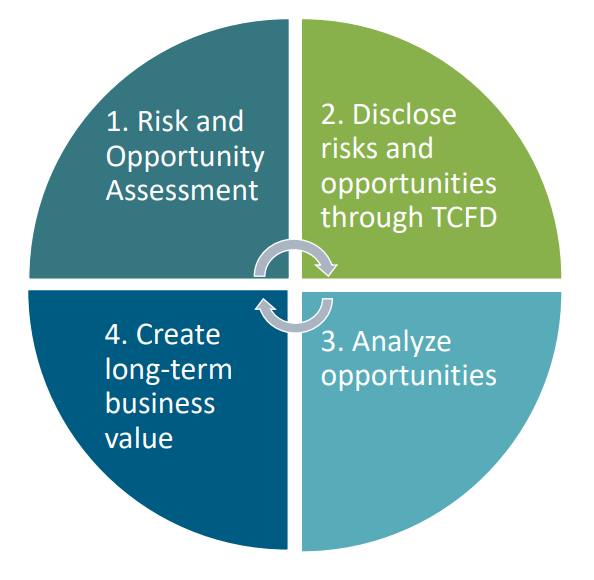The impacts of climate change are very real and there is an increasing pressure on businesses to step up and act. In a webinar moderated by Antea Group’s Vice President of Risk and Financial Services, Ben Hansen, two of our Task Force on Climate Related Financial Disclosure (TCFD) experts provided tangible knowledge on how to conduct TCFD-aligned analysis and prepare public disclosures. Nick Martin, Sustainability Practice Lead, and Nate Kimball, Climate Solutions Lead, cover topics including what TCFD is and why it's important, types of climate risk, and how to begin implementing TCFD.
If you missed the webinar, you can catch it on-demand anytime!
Watch On-DemandWhy TCFD and Why Now?
“We know that climate risk is a dominant risk across all industries” shared Nate Kimball. Business risks are rapidly increasing in a warming world and understanding these risks provides downside protection and greater business resiliency. Knowing this, businesses should be preparing for a variety of scenarios from a more pessimistic view (i.e., extreme global warming) to more optimistic scenarios (i.e., low carbon economy).
TCFD provides a helpful framework for businesses as they evaluate these risks. It allows for transparent and replicable analysis of climate-related risks and opportunities across companies’ global asset portfolios and helps identify actions that can reduce risk while creating long-term value.
What is TCFD?
TCFD is a program led by the Financial Stability Board (FSB). TCFD creates a standard through which companies publicly disclose climate risks and opportunities. The TCFD is currently voluntary but regulatory bodies around the world (including the SEC in the U.S.) are considering mandatory climate-related disclosures. TCFD is an investor-focused framework and focuses on uncovering “decision-useful” information about a company’s climate-related risks and opportunities.
Types of Climate Risk:
When leveraging the TCFD framework, it's important to evaluate the types of risks associated with your operations and the severity of their impact on your business. TCFD focuses on four types of climate risks:
- Chronic Physical Risks: These risks compound over time and introduce long-term stress to physical assets. Some examples include sea level rise, water scarcity, temperature extremes, and allocation limits.
- Acute Physical Risks: These risks are one-time events or “shocks” that have an immediate impact and are difficult to predict. Examples include wildfires, rainstorms, heat waves, and extreme weather events.
- Regulatory Transition Risks: These risks are emerging with increasing mandates and regulations. Litigation risks and environmental regulations are two examples.
- Market Transition Risks: These risks can be difficult to grasp but can have a great impact. Examples include investor decision making, consumer preferences, and volatile input costs that impact operations.
TCFD Disclosure Requirements
TCFD requires your business answer 11 specific questions about companywide geographic exposure to physical and transition risks. It focuses on questions around risk exposure as well as on the management of climate-related risks across the organization. The TCFD recommendations provide guidance for how companies should structure aligned disclosures based upon four-pillar guidance. The four pillars are outlined below:

Implementing TCFD
Achieving TCFD doesn’t have to be hard! Assessing climate risks doesn’t require sophisticated climate models and can be done using publicly available tools and interpretation.
Starting with scenarios, we have a few helpful tips – most importantly, don’t overthink it! Scenarios can offer great insight; however, they won’t change your risk profile. We recommend against spending all of your resources evaluating distinct climate scenarios or investing in sophisticated modeling for your assets. Instead we recommend focusing on comparative risks that are most relevant and tangible to your business. Don’t forget to evaluate your operations and supply chain for vulnerabilities and interdependencies.
When you’re ready to start implementing TCFD, we’ve outlined four steps for you to follow to help the process go smoothly:
- Risk and Opportunity Assessment: Start by gathering and assessing data. During this step you will identify the physical and
 transition risks that apply to your business and, using the data collected, prioritize actions based on the severity of the risks.
transition risks that apply to your business and, using the data collected, prioritize actions based on the severity of the risks. - Disclose Risks and Opportunities through TCFD: Disclosing risks and opportunities early is highly important. By waiting to disclose, your business could be perceived as “silent" on important climate issues. Communicate the value of resilience and sustainability investments to your stakeholders early on and future-proof your sustainability reporting against future SEC regulations.
- Analyze Opportunities: During this stage, it is time to act. Develop plans and create strategies based on the analysis done in step one. Use this step to divest high-risk locations and products and participate in private markets for low-carbon capital investment such as green bonds.
- Create Long-Term Business Value: Finally, focus on creating value through TCFD. Attract and retain investors and customers, reduce litigation risk, manage operational and capital costs, retain a health workforce, and guide your long-term corporate strategy.
Learning all the ins and outs of reporting and disclosure can feel overwhelming at times. But you don’t have to figure it all out on your own. At Antea Group our Corporate Sustainability Reporting and Disclosure team can help you every step of the way.
Contact Us Today to Get StartedWant more news and insights like this?
Sign up for our monthly e-newsletter, The New Leaf. Our goal is to keep you updated, educated, and even a bit entertained as it relates to all things EHS and sustainability.
Get e-NewsletterHave any questions?
Contact us to discuss your environment, health, safety, and sustainability needs today.






